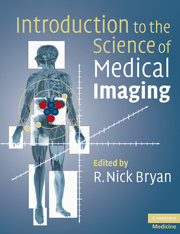9 - Contrast agents for x-ray and MR imaging
Published online by Cambridge University Press: 01 March 2011
Summary
Radiographic contrast
In Chapter 5, the basic physics of x-ray imaging was described. To briefly review, the x-rays are generated by the electrons in the x-ray tube striking the anode at high energy. More specifically, the energy of the electrons (in electronvolts, eV) is numerically equal to the kilovoltage applied to the anode. This creates a beam of external x-rays that has a very wide energy spectrum. The x-ray energies cover a range from (theoretically) 0 eV up to a maximum equal to the applied kilovoltage. In practice, because low-energy x-rays are much more rapidly absorbed than those with higher energies, the very lowest x-rays are absorbed in the glass envelope of the x-ray tube. More to the point, x-ray tubes are always operated with an additional metallic layer covering the opening port. This is called the “filter” and is intended further to raise the minimum x-ray energy. Because lower-energy x-rays are also absorbed by the human body more readily than those of higher energy, the absorption of the low-energy rays will contribute ionization dose to the patient's tissues without significantly contributing to image contrast, which is undesirable. Thus the radiologist can vary the so-called “effective energy” of the beam, usually by adjusting the applied kV, or occasionally by adding more metal as filter. The exact technique used depends on various factors, including the thickness of the body part being imaged and the nature of the pathology expected.
Information
- Type
- Chapter
- Information
- Introduction to the Science of Medical Imaging , pp. 183 - 195Publisher: Cambridge University PressPrint publication year: 2009
